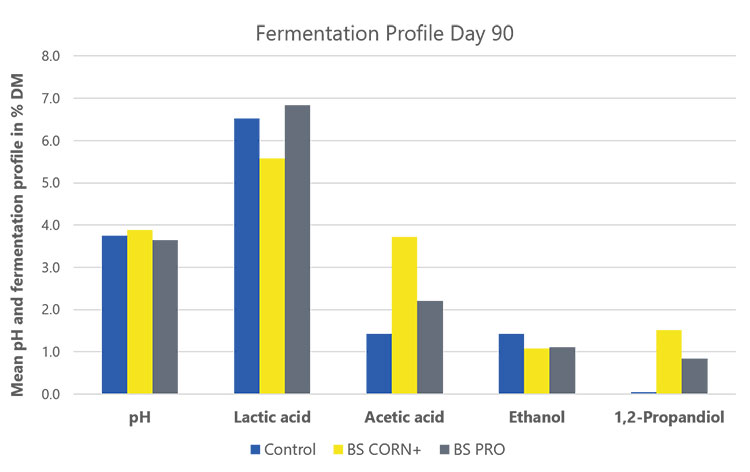
Corn silage season is upon us, and growers are doing all they can to make sure their corn silage is at optimal quality. As growers check for quality, one area they should pay special attention to is the fermentation process. To ensure the fermentation process went well for silage, there are several indicators growers can check, including fermentation profiles and pH. But one area that growers need to pay attention to is whether spoilage microorganisms are present in their silage.
Spoilage microorganisms: fermentation’s nightmare
When it comes to corn silage, growers need to monitor what occurs to the silage during feed out and the overall aerobic stability of the feed. Aerobic instability can be a result of spoilage microorganisms like yeasts and molds and these microorganisms can also account for losses of valuable nutrients and dry matter.
Luckily, acetic acid can be used to fight these yeasts and molds and can protect against dry matter (DM) and energy losses during feed out. Unfortunately, it can be tricky to determine where acetic acid is coming from and the efficiency of that production. So, growers often wonder: How do we know when acetic acid production is desirable and most effective?
Simply put, the efficiency of acetic acid production is determined by the types of microorganisms that dominate the fermentation. Inefficient acetic acid production comes from “wild” fermentations that are driven by microorganisms like Enterobacteria. Along with degrading the quality of the silage by using up valuable nutrients, these microorganisms can produce other metabolites that can be toxic and affect intake.
The solution to obtaining acetic acid levels efficiently is to use an inoculant containing a microorganism like Lactobacillus buchneri. These heterofermentative microorganisms can dominate the fermentation and efficiently produce acetic acid with minimal DM and nutrient losses. Controlling the fermentation with a research-proven inoculant can help us dominate the wild population of microorganisms and produce high-quality silage.
The silage inoculant difference
When it comes to producing high-quality forage, ensuring there is minimal DM and nutrient losses is key. But even the most well-managed piles can have fermentation processes go wrong. In severe situations, the forage can become completely unpalatable and therefore become a total loss. The use of an inoculant can be a powerful tool to help protect against many situations where inefficient or mis-fermentations may occur.
During a batch fermentation trial, we evaluated the fermentation profile of corn silage samples treated with BONSILAGE CORN+ (BS CORN+) and BONSILAGE PRO (BS PRO) compared to corn silage not treated with an inoculant (Figure 1). The average DM of samples tested was 32.7% ± 0.55. The fermentation profile is characterized by pH, lactic acid, acetic acid, ethanol, and 1,2- propanediol.

When comparing BS PRO that contains a combination of Lb. brevis, Lb. plantarum, and Lb. buchneri at an application rate of 150,000 cfu/g of fresh forage, the BS PRO was able to successfully dominate the fermentation and produce more of both lactic and acetic acid (6.8% and 2.2% DM). Higher levels of efficiently produced acetic acid not only provide better protection against reheating but allows for the delivery of high-quality silage to the cow.
BS CORN+, our premium treatment for corn silage, contains a combination of Lb. plantarum and Lb. buchneri at an application rate of 500,000 cfu/g of fresh forage.

Due to this high concentration of Lb. buchneri, there is a slightly lower amount of lactic acid compared to the control. The Lb. buchneri efficiently converted lactic acid to acetic acid to obtain higher levels of acetic acid than the control (3.7% DM vs. 1.4% DM). This provides better aerobic stability and protection against dry matter losses during feed-out. Within the BS CORN+ formulation, the Lb. buchneri strain present can produce significant amounts of 1,2-propanediol or more commonly known as propylene glycol (PG).
Using inoculants today
To learn more about improving the quality of the silage you produce, talk to a BONSILAGE USA specialist today. BONSILAGE USA specialists can share insights to help support the profitability of your operation and the wellness of your animals.



